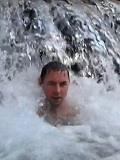| ← Back stroke | Dive in → |
Swimming Hole Heaven in the Northern TerritoryYour guide to the best swimming holes
| World Home Page |
| - Australia |
| - Northern Territory |
| Other information: |
| Water Safety |
| Map |
| List of Lists |
| Your Support |
 The Northern Territory is home to some of the most spectacular swimming holes in the world.
Swimming Hole Heaven is currently focussed on the area around Darwin and Litchfield National Park.
The pick of the bunch are definitely Berry Springs (about an hour south of Darwin)
and Wangi Falls (in Litchfield National Park). I would challenge anyone to find better
swimming holes than these anywhere in the world!
The Northern Territory is home to some of the most spectacular swimming holes in the world.
Swimming Hole Heaven is currently focussed on the area around Darwin and Litchfield National Park.
The pick of the bunch are definitely Berry Springs (about an hour south of Darwin)
and Wangi Falls (in Litchfield National Park). I would challenge anyone to find better
swimming holes than these anywhere in the world!
The dry season runs roughly from April to October, with very little rainfall from May through to September inclusive. The best time to visit Darwin and Litchfield National Park is in the middle of the dry season (June, July, August). Temperatures are still hot during this period, with an average daily maximum in excess of 30 degrees celcius. Despite the lack of rain there is plenty of fresh water in the swimming holes from the numerous natural springs in the region.
Select Your Swim:
Click on the heading of each location to find your next swimming day trip or holiday destination.
If you want a quick overview of these swimming holes, take a look at the video at the bottom of the page.
Swim safe, have fun and remember that no matter how cold the water is, it's alright once you're in!
Berry Springs, near Darwin
 This spot has naturally warm water, two giant pools connected by a shallow channel, crystal clear visibility and a shoulder massaging cascade.
What more could you ask for in a swimming hole? Bring a snorkel mask to explore the larger pools…
This spot has naturally warm water, two giant pools connected by a shallow channel, crystal clear visibility and a shoulder massaging cascade.
What more could you ask for in a swimming hole? Bring a snorkel mask to explore the larger pools…
Buley Rockhole, Litchfield National Park
 Scramble across the rock shelves and launch yourself into one of the deep pools in these cascades in Litchfield
National Park. I thought they might be bottomless until I saw a local come up from the bottom with tourists' lost jewellery…
Scramble across the rock shelves and launch yourself into one of the deep pools in these cascades in Litchfield
National Park. I thought they might be bottomless until I saw a local come up from the bottom with tourists' lost jewellery…
The Cascades, Litchfield National Park
 A little harder to get to than other swimming spots in Litchfield National Park, but it is a little less crowded too.
This long lava flow has several shallow pools for splashing around in after the short but sapping walk to get there…
A little harder to get to than other swimming spots in Litchfield National Park, but it is a little less crowded too.
This long lava flow has several shallow pools for splashing around in after the short but sapping walk to get there…
Darwin Waterfront
 If you are getting sticky in Darwin and need a swim to escape the heat, try out the wave pool or the croc-free
lagoon at the Darwin Waterfront. I'm not a huge fan of the lagoon, but the wave pool is fun. One of the
few options in town…
If you are getting sticky in Darwin and need a swim to escape the heat, try out the wave pool or the croc-free
lagoon at the Darwin Waterfront. I'm not a huge fan of the lagoon, but the wave pool is fun. One of the
few options in town…
Florence Falls, Litchfield National Park
 At this spot you can swim amongst some curious but friendly sooty grunters close to the shore in this natural rock cathedral filled by two waterfalls. It can
get dark here in the late afternoon, so time your visit for the middle of the day…
At this spot you can swim amongst some curious but friendly sooty grunters close to the shore in this natural rock cathedral filled by two waterfalls. It can
get dark here in the late afternoon, so time your visit for the middle of the day…
Wangi Falls, Litchfield National Park
 This is a breathtaking place for swimmers. Immerse yourself in the massive pool of crystal clear water filled by a huge waterfall. After
visiting many swimming holes around the world, this remains truly one of the best you will find…
This is a breathtaking place for swimmers. Immerse yourself in the massive pool of crystal clear water filled by a huge waterfall. After
visiting many swimming holes around the world, this remains truly one of the best you will find…
Historical (but now defunct) Swimming Holes:
Here are former swimming holes that are now closed to swimmers.
Howard Springs, near Darwin
 Howard Springs was a popular spring fed swimming hole up until the bats moved in. Admire this
former swimming hole from the splash pad built next to the now contaminated lagoon. You can
also have a picnic here under the canopy of some large trees…
Howard Springs was a popular spring fed swimming hole up until the bats moved in. Admire this
former swimming hole from the splash pad built next to the now contaminated lagoon. You can
also have a picnic here under the canopy of some large trees…
All of the sites in the Northern Territory on this website are accessible by 2WD vehicle in the dry season. A small number of additional swimming holes in Litchfield National Park are only accessible by 4WD. I haven't documented these because I haven't personally visited them. There are several more swimming holes a couple of hours further south in the Katherine region and some in Kakadu, which from what I've heard are well worth visiting. I haven't documented them because I haven't personally visited them yet.
Most swimming holes are closed during the wet season due to flooding or risk of crocodile attack. Reading the swimming safety information is extremely important in the Northern Territory as you could be risking your life if you don't.
Here is a compilation video of some of the above swimming holes for those pressed for time or with short attention spans:
If you know of a swimming hole in the NT that you think I would like to visit, feel free to suggest a site.
Too wet for a swim? Visit a waterfall
 My companion website Waterfall Seasons of Australia lists
all of the waterfalls that I have visited during my search for swimming holes. In the NT, it currently mostly duplicates
the above list, but with some additional information about the falls themselves such as their approximate dimensions.
My companion website Waterfall Seasons of Australia lists
all of the waterfalls that I have visited during my search for swimming holes. In the NT, it currently mostly duplicates
the above list, but with some additional information about the falls themselves such as their approximate dimensions.
| ← Back stroke | Dive in → |
| Australia | NT |
| Water Safety | Map |
| Links | Your Support |
| List of Lists | Suggest a Swim |
| Community, Media, Research | |
|
|
|
|
|
|
|
|
|
|
© Brad Neal 2024. All rights reserved. Swimming Hole Heaven is a registered trademark. Here are my
affiliate links and cookies policy and opportunities to provide support to Swimming Hole Heaven.
